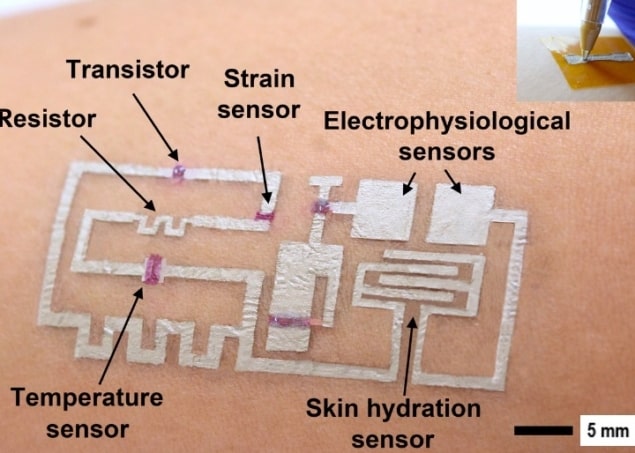Electronics drawn directly on the skin creates robust biosensors
19 Aug 2020 Samuel Vennin
Researchers from the University of Houston have developed a new form of bioelectronics known as “drawn-on-skin” (DoS) electronics, in which multifunctional sensors and circuits can be drawn directly onto the skin with a specialized ink pen. Their study, published in Nature Communications, shows that information collected using DoS electronics is more reliable and consistent than that obtained with electrodes commonly used in wearable bioelectronics.
“[The circuits are] applied like you would use a pen to write on a piece of paper,” says senior author Cunjiang Yu. “We prepare several electronic materials and then use pens to dispense them. Coming out, it is liquid. But like ink on paper, it dries very quickly.” Senior author Cunjiang Yu.
Senior author Cunjiang Yu.
 Senior author Cunjiang Yu.
Senior author Cunjiang Yu.
Yu and colleagues used three different inks to draw the various elements of the bioelectronic platform (conductors, semiconductors and dielectrics) into the outlines of a stencil. Any imperfection can be corrected by simply drawing on top of it. Once dried, the drawn structure can deform with the skin and collect a wealth of physiological signals.
Conventional wearable bioelectronics generally suffer from motion artefacts that lead to data misinterpretation and misdiagnoses. These artefacts mainly arise when weak adhesion or imperfect conformability create an inconsistent interface between the electronics and the skin. When drawn on the skin, however, DoS electronics form an ultra-conformal, robust and stretchable interface that is immune to the skin’s motion.
A wealth of physiological signals
The team investigated the various measurement possibilities offered by the sensors. For example, by tracking variations in the sensors’ resistances, the researchers found that they could detect tissue deformations or changes in ambient temperature. Further experiments also revealed that DoS sensors are able to record skin impedance, from which hydration levels of the skin layers could be extrapolated, even under strain.
Of the various measurable features, however, none might be more important than electrocardiograms (ECG) as they can help to predict and prevent imminent cardiovascular events such as arrythmia. DoS sensors not only provide a clear ECG signal but can also track changes in heart rate, which highlights their potential as monitoring tools.
When compared against a hospital-grade gel electrode and an ultrathin serpentine-mesh electrode, the DoS sensor was the least affected by the presence of sweat and was the only sensor able to provide a robust ECG signal over a 7-hr period. Interestingly, ECG recordings obtained from the DoS sensor showed no abnormal deviations when undergoing regular intervals of stretching, compressing and releasing of the skin at their site of deposition, in contrast to the two other sensors.
Additional studies revealed that the sensors could also capture electromyographic signals – the electrical activity of muscles. Throughout all these experiments, DoS sensor signals were not subject to motion artefacts, which constitutes a major improvement over standard wearable bioelectronics.
Better than a bandage?
The most fascinating feature of this novel sensor, however, might be its ability to speed up wound healing. Pulsed electrical stimulation of the skin has been shown to accelerate wound recovery and the researchers tested whether their DoS sensor could induce such a process. They surgically created a 1 cm wide skin wound in mice and then drew electrodes only on the top half of the wound. After five days, the scab width on the treated side had reduced by an average of 8 mm whereas the scab on the untreated half had only decreased in width by 4 mm, on average. Such devices could be of great use, for example, in low-resource environments or on battlegrounds.
DoS electronics are simple to fabricate without requiring dedicated equipment. They can construct active electronics, with multi-functional devices and sensors, and are inherently immune to motion artefacts. As such, they represent a promising technology to keep an eye on in the field of bioelectronics and personalized point-of-care treatments
FROM PHYSICSWORLD.COM 23/8/2020

Δεν υπάρχουν σχόλια:
Δημοσίευση σχολίου